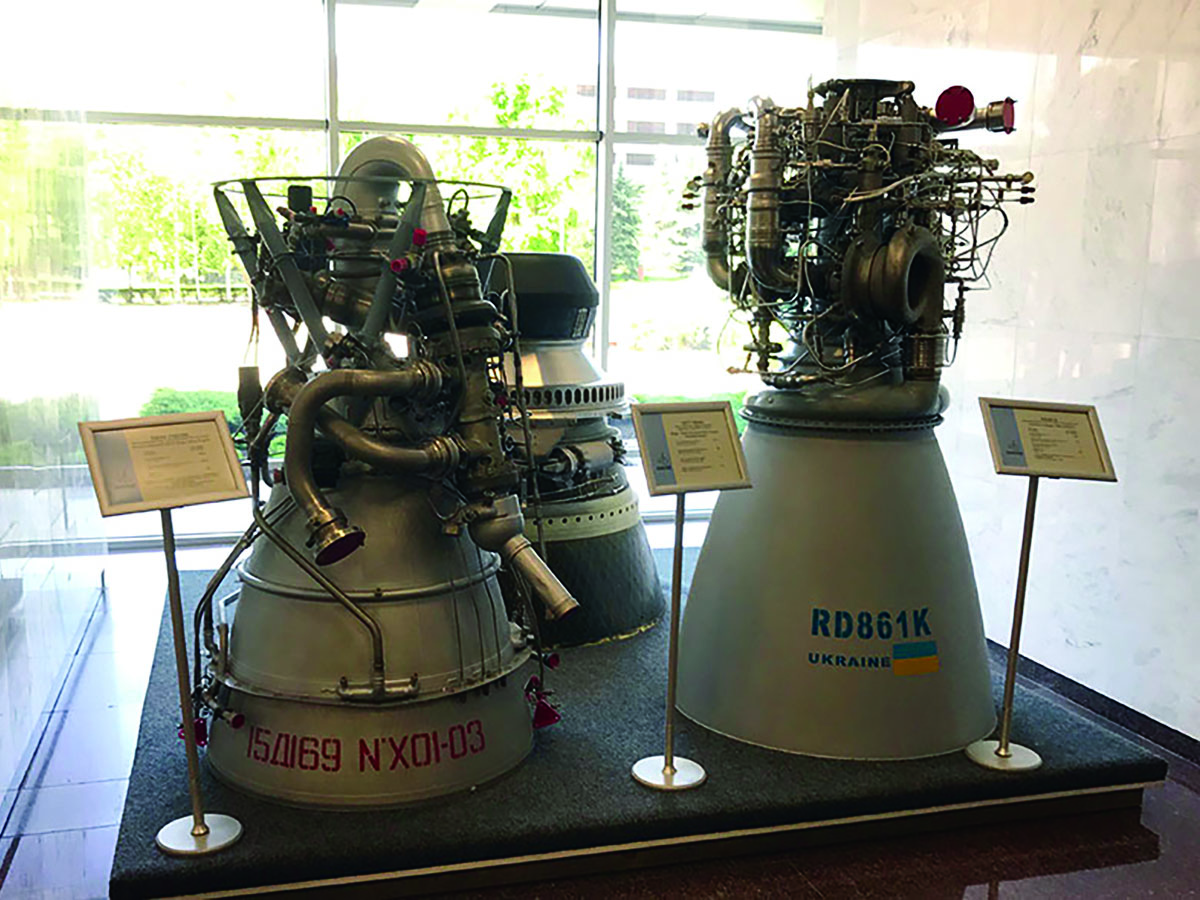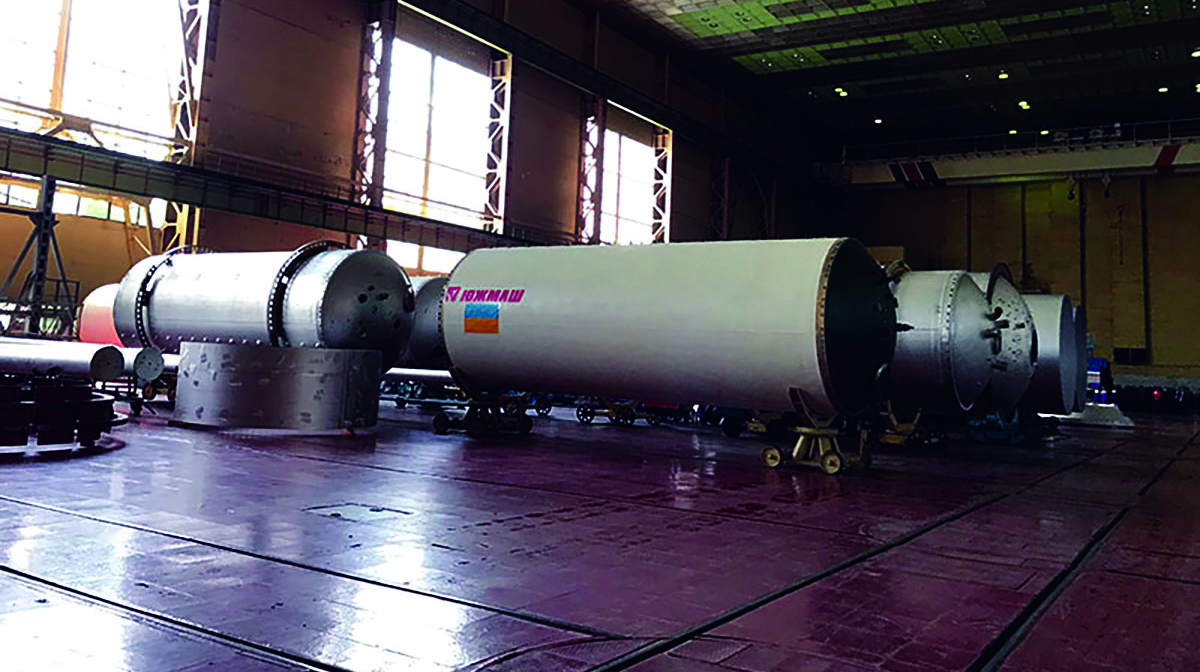Stay Up to Date
Submit your email address to receive the latest industry and Aerospace America news.
The leading space company in Ukraine hopes to break into the hypercompetitive international satellite launch market with a novel business strategy and a new line of expendable rockets to be called Cyclone-4Ms.
The proposed two-stage rockets will borrow the Cyclone name from a family of vehicles that once flew from sites in Russia and Kazakhstan and were also a basis for a failed Ukrainian-Brazilian joint venture. The new rockets would lift off from a proposed site on Canada’s Atlantic Coast, provided an ongoing fundraising effort is successful. The site near the town of Canso in Nova Scotia is well situated for delivering lightweight satellites into near-polar orbits.
Earlier this year, I visited KB Yuzhnoye, which plans to manufacture the Cylone-4Ms in the city of Dnipro. It was a rare chance to see already manufactured hardware and testing facilities that were developed for the failed Ukrainian-Brazilian initiative, but which can now be repurposed for the Cyclone-4M fleet. Key managers and engineers behind the latest effort were on hand to outline their strategy for the future.
Despite an extremely complex political and economic situation in today’s Ukraine, Yuzhnoye hopes to do more than weather the downturn in the country’s space budget. It wants to break into the competitive satellite launch market dominated by the Russian Soyuz rockets, Elon Musk’s Falcon 9s and the Indian Polar Satellite Launch Vehicles.
To push the business side of the project, Yuzhnoye hired a veteran of the U.S. space industry, John Isella, who previously worked on the Antares rocket project for NASA and, later, for the Antares manufacturer, Orbital ATK. Developed under a NASA contract for flights to the International Space Station, each Antares includes a Yuzhnoye -built first stage.
Now, Yuzhnoye hopes to borrow heavily from its experience in the ongoing Antares project to develop the Cyclone 4M.
Isella, who moved to Dnipro and bought a flat in the city, also represents the Yuzhnoye Design Office in the United States and is CEO of Maritime Launch Services, MLS, created specifically to operate the Cyclone-4M rockets in Canada.
Isella says fundraising for the initial phase of the Cyclone-4M project is ongoing, but he adds that he is optimistic.
He points out that its $45 million price per launch is low, and he says Cyclone-4M will be perfectly sized for the job of delivering the small satellites that are increasingly popular. “Although SpaceX is offering very low cost per kilogram, many of the launch requirements that are coming in the immediate future do not require the full capacity of the Falcon 9 vehicle,” Isella says. “So even though Cyclone-4M will have a higher cost per kilogram, it is a better fit for what our customers are telling us they are going to need in the next five or 10 years.”
On the technical side, Yuzhnoye must organize the serial production of the large engine that will propel the first stage of each Cyclone-4M. This engine, designated the RD-870, has yet to be built. Designers might have stayed with the RD-120s that propelled the Ukrainian-Russian Zenit rockets, but the combustion chambers for those engines would need to be imported from Russia, which is impossible due to the seemingly intractable conflict between the two former Soviet republics that has also stalled the Zenits.
Vladimir Shulga, Yuzhnoye deputy designer general, who is responsible for propulsion systems at the company, expressed confidence that the new power plant can be built cheaply inside Ukraine. “We estimate that we will spend three times less money [on RD-870] in comparison to the development of a new engine,” he says. “We extensively borrow the technology, experience, manufacturing base and even some modes of operation from the existing systems,” Shulga says. “We still have to test [the new engine], but we would need only one prototype and not, say, five. We have a test stand suitable for it, allowing firing engines up to 93 tons in thrust, which would only need some interface upgrades.”
As of May, Yuzhnoye planned to complete the preliminary design for the four-engine cluster of RD-870 engines by September. Moving forward, Yuzhnoye is working on organizing an industrial team of subcontractors inside Ukraine for mass production of the engine.
Shulga estimates that it would take between 3.5 and four years to set up a complete RD-870 production line. If successful, RD-870 will be the first large rocket engine for the first stage of an indigenously built vehicle in Ukraine.
In the meantime, for its second stage, Cyclone-4M will fly the RD-861 engine, which is undergoing final testing aimed to qualify it for flight. Originally developed for the canceled Cyclone-4 project, the engine is practically ready and the Ukrainian engineers are already working on its upgrades, including the new controller, which will perform computerized monitoring of the ratio between fuel and oxidizer flowing into the combustion chamber.
However, the major disadvantage of this motor is its propellant components inherited from military missiles: unsymmetrical dimethyl hydrazine, UDMH, and nitrogen tetroxide. Besides being extremely toxic, these chemicals are also quite expensive. And hydrazine has never been produced in Ukraine. Just to run the engine tests, Yuzhnoye has to buy hydrazine in China, explains Aleksandr Kushnarev, first deputy designer general for system design at Yuzhnoye .
As a result, Ukrainian engineers had already begun work on the kerosene-burning engine — RD-809K — that is intended to propel the next generation second stage on Cyclone-4M.
Upgraded with RD-809K, Cyclone-4M will be able to deliver around 4 tons to low Earth orbit, greatly expanding its potential on the international market.
Not coincidently, Isella says that all launch facilities at the future launch site in Canada would feature the built-in capability to support much larger rockets than the original Cyclone-4M.
Editor’s note: The photo at the top of this page shows rocket components at the Yuzhmash factory in Dnipro, Ukraine.
“Although SpaceX is offering very low cost per kilogram, many of the launch requirements that are coming in the immediate future do not require the full capacity of the Falcon 9 vehicle. So even though Cyclone-4M will have a higher cost per kilogram, it is a better fit for what our customers are telling us they are going to need in the next five or 10 years.”
John Isella of Ukrainian space company KB Yuzhnoye
About Anatoly Zak
The publisher of RussianSpaceWeb.com, Anatoly has also written for Air & Space Smithsonian magazine.
Related Posts
Stay Up to Date
Submit your email address to receive the latest industry and Aerospace America news.





